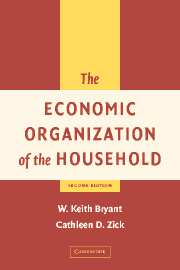Book contents
- Frontmatter
- Contents
- List of Figures
- Preface to the Second Edition
- 1 Introduction
- 2 Household Equilibrium
- 3 The Analysis of Consumer Demand
- 4 Consumption and Saving
- 5 Work and Leisure : How the Household Spends Its Time
- 6 Human Capital : Investing in Oneself and One's Family
- 7 The Economics of Fertility
- 8 The Economics of Marriage and Divorce
- References
- Index
Preface to the Second Edition
Published online by Cambridge University Press: 06 July 2010
- Frontmatter
- Contents
- List of Figures
- Preface to the Second Edition
- 1 Introduction
- 2 Household Equilibrium
- 3 The Analysis of Consumer Demand
- 4 Consumption and Saving
- 5 Work and Leisure : How the Household Spends Its Time
- 6 Human Capital : Investing in Oneself and One's Family
- 7 The Economics of Fertility
- 8 The Economics of Marriage and Divorce
- References
- Index
Summary
In 1987, when we began writing the first edition of The Economic Organization of the Household in earnest, there had been no attempt to gather the threads of the research and discussion on the economics of the family, weave them together, and present them as a whole cloth to either the undergraduate or beginning graduate student. Since then, a flood of research has been published in response to the trends in family behavior, some of which raised puzzling social policy questions. Simultaneously, a host of national cross-section and panel data sets that could be used to test hypotheses about family behavior became available. The Handbook of Population and Family Economics, edited by Mark Rosenzweig and Oded Stark (1997), has provided researchers and advanced graduate students with useful discussions of models, hypotheses, and empirical research on the subject from both economics and demography. But to our knowledge, with all its faults, The Economic Organization of the Household remains the single source of an integrated treatment of the economics of the family at the senior undergraduate and first-year graduate student level. It seemed worthwhile, therefore, to revise it: by including the research done since 1989 as well as some earlier research neglected in the first edition, by including some topics not covered in the first edition, and by dropping a few topics that teachers have said were less useful or dated.
- Type
- Chapter
- Information
- The Economic Organization of the Household , pp. xiii - xviPublisher: Cambridge University PressPrint publication year: 2005

